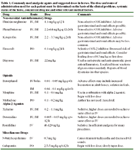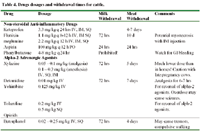Pain management in food and fiber animals: What are our alternatives? (Proceedings)
Pain management in food and fiber producing ruminants is often more problematic than in other domestic species.
Pain management in food and fiber producing ruminants is often more problematic than in other domestic species. Analgesic protocols have not historically been incorporated into routine agricultural animal treatment plans because of the perception that they are too time-consuming, too costly, and too impractical for routine use. This is further exacerbated by subtle clinical signs of pain that are often poorly understood and under-recognized. Because there has been relatively little emphasis on pain management in food and fiber animals, it is not surprising that pharmacologic management of pain is sharply limited by availability of drugs licensed for use in food-producing animals, a lack of information regarding therapeutic analgesic strategies in these species, and related concerns regarding drug withdrawal times to avoid residues in meat or milk.

Table 1. Commonly used analgesic agents and suggested doses in horses. The dose and route of administration used for each patient must be determined on the basis of the clinical problems, systemic status of the horse, concurrent drug use and other relevant medical factors.
Today the incorporation of analgesic treatments into agricultural animal medicine is slowly increasing world-wide in response to three very different influences. First, our abilities to recognize the behavioral signs of pain are improving for all animals species with resultant increasing awareness of the presence of pain in our patients. Second, an enhanced understanding of the adverse effects of uncontrolled pain on the well-being of animals and hence, on their long term production capacity, has increased the willingness of producers to spend the time and money required for analgesia in association with routine surgical procedures. Finally, there is growing world-wide demand for animal products produced in a "cruelty free" environment and increasing numbers of consumers are willing to pay higher prices for such products.

Table 2 Drugs for continuous rate infusion (CRI) for analgesia in horses.
Behavioral Responses to Pain in Ruminants
Behavioral signs of pain in ruminants are often quite subtle and may primarily manifest as an absence of normal behaviors. Cattle and sheep in pain may appear dull, depressed, and show little interest in their surroundings, separating themselves from the herd or flock. Unusual behaviors by an individual, not manifested by other animals in the group, may suggest the presence of pain. In cattle, these unusual behaviors may vary from total inactivity to restlessness to obvious hyperactivity. Any painful condition may impair rumen motility and cause a sudden decrease in milk yield. Cattle with abdominal pain may show abdominal splinting, grunting, tooth grinding, or arched back. More specific signs of abdominal pain such as kicking at the abdomen or rolling are less common in cattle than in horses. In sheep, grinding of teeth, head pressing, lip curling and cessation or rumination may occur with severe pain. After castration or tail docking indicators of pain in lambs may include repeatedly laying down and standing up, wagging their tails, or remaining immobile while standing. Goats tend to vocalize more in response to pain than do cattle or sheep. As with horses, ruminant species may show changes in their responses to human interaction as a result of pain. This may manifest as rigidity of posture, violent responses, or resentment of handling. Chronic pain may be manifested as changes in personality, loss of appetite, and decreased grooming behavior.

Table 3 Drugs used for epidural analgesia in horses.
Nonsteroidal Anti-Inflammatory Drugs
Although there are no nonsteroidal anti-inflammatory drugs (NSAIDs) specifically approved for use in food producing animals in the United States, the drugs are generally considered useful for their antipyretic, analgesic, and anti-inflammatory effects. Ketoprofen has been shown to significantly reduce plasma cortisol response to dehorning and castration in calves. Most NSAIDs are acidic and do not penetrate well into milk and the milk withdrawal times tend to be quite short. However, these drugs are highly protein bound and may have long withdrawal times for meat. The exception is ketoprofen which has a very short half life and does not produce significant residues in milk or meat. In 2003 the Food and Drug Administration prohibited use of phenylbutazone in female dairy cattle 20 months of age or older.

Table 4. Drugs dosages and withdrawal times for cattle.
Opioids
Opioids are generally considered to be ineffective for pain management in ruminants. They may produce tremors, hyperactivity, increased locomotor activity, and increased chewing behavior. Many opioids are highly lipid soluble, making them likely to reach the milk with resultant concerns for drug residues. The most widely used opioid in ruminants is probably butorphanol, a mixed kappa agonist and mu antagonist. In sheep butorphanol at 0.2 mg/kg IM may provide visceral analgesia for 2 to 3 hours. Morphine has poor analgesic effect in most ruminants and is inactivated in the rumen. Morphine may be effective in goats but no meat or milk withdrawal times have been established. Transdermal fentanyl adminstration is anecdotally thought to be beneficial for alleviating pain in goats and camelids; however, to date there is no data to support these observations.
Local Anesthetics
Pain management for routine surgical procedures such as dehorning, tail docking, claw amputation, etc. often includes local anesthetics to block sensory nerves in the surgical area. Lidocaine is metabolized rapidly and lasts for about 45 minutes in most ruminants. Bupivicaine has a longer duration of action of up to 6-8 hours. Care must be taken with use of lidocaine in goats. Total body doses of greater than 5 mg/kg may be associated with toxicity with signs of ataxia, depression, and seizures.
Podcast CE: A Surgeon’s Perspective on Current Trends for the Management of Osteoarthritis, Part 1
May 17th 2024David L. Dycus, DVM, MS, CCRP, DACVS joins Adam Christman, DVM, MBA, to discuss a proactive approach to the diagnosis of osteoarthritis and the best tools for general practice.
Listen